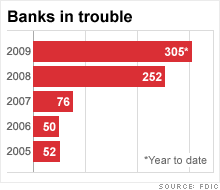Problem bank list tops 300
FDIC reports that the number of troubled lenders rose by more than 50 during the first quarter and hit its highest level since 1994.
 |
| The number of banks on the FDIC's problem list now stand at 305, based on figures published Wednesday. |
NEW YORK (CNNMoney.com) -- The government's list of troubled banks swelled in the first quarter, climbing to its highest level in nearly 15 years, regulators said Wednesday.
The Federal Deposit Insurance Corp. said that the number of lenders on its so-called "problem bank" list jumped to 305 during the first three months of 2009, from 252 in the fourth quarter of last year. This is the highest level of troubled institutions since 1994.
"Banks are making good efforts to deal with the challenges they're facing, but today's report says that we're not out of the woods yet," FDIC Chairman Sheila Bair said in a statement.
Banks deemed troubled by regulators typically face difficulties with their finances or have operational or management issues that pose a threat to their existence.
Lenders that land on the list are considered the most likely to fail, although few actually reach that point. On average, just 13% of banks on the FDIC's problem list have failed.
Regulators never disclose the names on the list out of fear that depositors at those institutions may prompt a so-called "run on the bank."
They do, however, provide the number of assets controlled by those institutions. In the first quarter, that number climbed to $220 billion, up from $159 billion as of the end of last year.
The sharp increase in asset size for troubled banks could be attributed to the inclusion of BankUnited (BKUNA), a Florida-based lender which oversaw nearly $13 billion in assets. Regulators shuttered the thrift last Thursday, and immediately sold much of its assets to a group of private equity firms.
So far this year, 36 banks have failed, including BankUnited. It is widely expected that many more banks will fail this year as banks of all sizes cope with rising loan losses as a result of the ongoing recession.
Even as the pace of failures quicken, it would be hard to match what happened during the savings & loan crisis two decades ago. More than 1,900 financial institutions went under during 1987-1991, peaking with the failure of 534 banks in 1989.
In the event of a failure, the FDIC fully insures individual accounts up to $250,000 for single accounts.
But the recent uptick in bank failures has taken a toll on the fund the FDIC uses to backstop consumer and corporate bank accounts.
In the first quarter, the value of the deposit insurance fund fell $4.3 billion, or 24.7%, leaving it with just over $13 billion.
Hoping to offset that decline, the agency announced a one-time assessment fee on all U.S. banks last week. This is expected to generate $5.6 billion for the fund.
Bair said Wednesday she would not rule out another assessment later this year, adding that she expected the fund to continue to decline in the coming months. She was quick to point out, however, that the FDIC did not plan on tapping its credit line to the Treasury Department, which was recently upped from $100 billion to as much as $500 billion through 2010.
Despite setting aside $61 billion for future loan losses, the more than 8,200 firms that make up the nation's banking industry managed to stay profitable in the first quarter.
The FDIC said banks collectively reported a net profit of $7.6 billion, compared to a loss of $26.2 billion in the fourth quarter of 2008.
Regulators speaking at Wednesday's event warned that loan deterioration remained their chief concern for the banking industry, particularly in areas like commercial real estate and loans made to businesses.
The percentage of loans and leases where borrowers were behind on payments climbed from 2.95% a quarter ago to 3.76% in the first quarter, representing its highest level since 1991.
One bright spot, however, was banks' ability to raise capital. Even though the bulk of that came from the Treasury Department's Troubled Asset Relief Program, or TARP, banks managed to raise a combined $82.1 billion in the first quarter.
Bair also tamped down recent speculation that banks would be able to bid on their own assets by selling them into the Treasury's Public-Private Investment Program. That program was unveiled earlier this year as a way for banks to rid themselves of toxic loans and securities stuck on their books.
She acknowledged that regulators were considering allowing some lenders to bid on other banks' assets, but that there still remained a lot of hesitancy on behalf of both buyers and sellers to participate in the program given the threat of additional legislative restrictions on participants.
"There are a couple of factors that are still at play here as we try to develop the structure and look for the launch of the program," she said. ![]()

